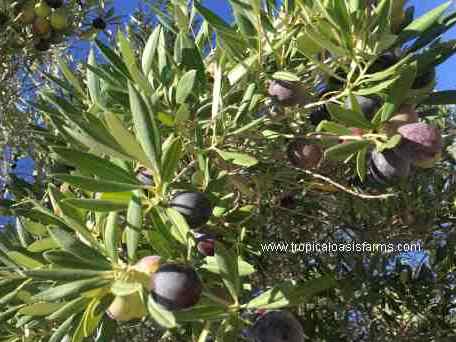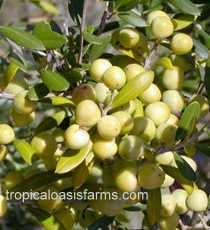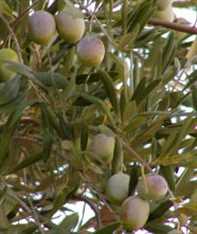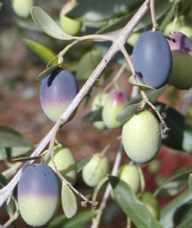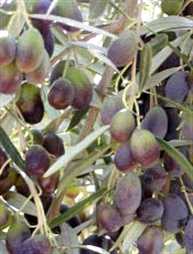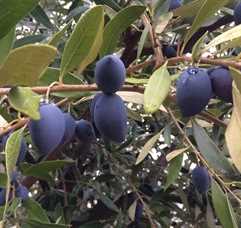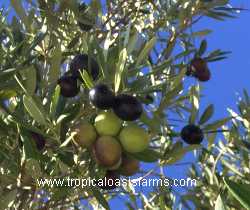Olive Information: Growing Olive Trees in California
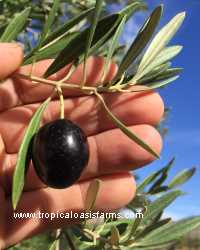 The olive is an attractive tree that grows very well in most of California.
The olive is an attractive tree that grows very well in most of California.
There are dozens of world famous olive cultivars, and most of these well known olive varieties originated in either Italy, Spain, France or Greece. Some olives are grown for their oil, while other varieties will be cured and then marketed as "table olives".
The flavor, texture and size are the most important characteristics for table olive varieties. There are some olive varieties that are very tasty as table olives, and that also have a good yield of high quality olive oil. The most well known of these dual purpose olive cultivars in California are Manzanillo, Mission, Sevillano and Kalamata. Coratina and Ascolano are also very popular cultivars for both table olives and for high quality oil. The oldest California table olive variety is the mission olive tree which was brought to the missions in Baja California from Spain about 300 years ago.
Olives like full sun in California, and once established they usually are very drought tolerant. Most olive tree varieties can withstand several degrees below freezing with little effect. In the Fall and early Winter before harvest however, temperatures below about 29�F will freeze the fruit making it unsuitable for oil.
When olive trees are first planted, the irrigation pattern should be close to the trunk so that the root ball of the tree is being watered. As the tree grows, the irrigation pattern should be moved away from the trunk closer to the drip line to encourage the roots to spread.
Most olives grown in California are evergreen small trees which commonly grow to about 20 feet tall. In California, olives are early flowering in spring with fruits typically ripening in October thru January.
Olive cultivars are propagated by cuttings, as well as by grafting.
Olives are easy to grow in most of California, requiring very little maintenance for the growth of healthy, productive trees. Fruit set and quality depends on adequate water supply at the time of fruit development.
Olives require very little pruning, just enough to keep an attractive shape..
Olive Background Information
The olive tree is native to Syria and Asia Minor. Olives are one of the first trees ever harvested by humans. Archaeological research shows that olives have been an important part of the human diet for more than 8,000 years. The ancient Assyrians discovered that edible oil with many other uses could be pressed from the olive fruit.
Olive Varieties
Arbequina Olive
The arbequina olive originated in Spain. It is a very popular oil-producing cultivar with high oil content (20-22%) and its relatively low polyphenol levels result in a milder, fruity flavor characterized by floral, nutty and tropical notes, with varying levels of grassiness depending on the harvest maturity. Arbequina oil is very popular for blending. The arbequina is a very early season olive with medium force of removal, and it ripens before most other varieties. Arbequina olive trees are very productive, and they produce a large crop every year under ideal growing conditions once mature. This cultivar has a relative low chilling hour requiement, making the arbequina a good choice for regions with mild climates. The arbequina olive tree is of medium vigor with a weeping shape. The arbequina cultivar is widely throughout Spain, Algeria, Argentina, Australia, Bolivia, Brazil, Chile, China, France, Israel, Peru and the USA, and it is very popular in recent high density olive orchards planted in California.
Ascolana Olive
The ascolana olive originated in Italy. It is a very large olive (8-10grams) with 16-18% oil content of high quality. Ascolana oil is becoming very popular for blending and also as a mono-cultivar oil. The ascolana is an early season olive, and it can be harvested at various maturities, with varying levels of pungency depending on the harvest maturity.
Coratina Olive
The coratina olive originated in Italy. The coratina is a mid to late season oil-producing cultivar with high oil content (21-26%), and the oil is exceptionally high in polyphenols, resulting in excellent stability.
The high polyphenol contents gives a strong bitterness when it is harvested green. Italian Coratina olives are traditionally harvested when very ripe, resulting in a more fruity oil with only moderate bitterness and pungency. The high polyphenol content of Coratina can make it a valuable addition to a blend when improved stability is desired, and it is very popular for blending.
Frantoio Olive
The frantoio olive originated in Italy. It is a very popular oil-producing cultivar with high oil content (17-22%). Frantoio is one of the most famous oil varieties being produced today. The oil yield is high and it is easily extracted. Frantoio is popular both in blends and as a single varietal oil with fruity character and a superb balance of fruitiness and pungency. Frantoio olive trees are very productive, and they produce a large crop every year under ideal growing conditions once mature.
Kalamata Olive
The Kalamata olive originated in Greece. It is also known as the kalamon olive. The kalamon is a world famous table olive cultivar with distinctive large fruit. The kalamon oil is of excellent quality and has a relatively high polyphenol content. The kalamon is a late season olive. The olive variety name Kalamata has Protected Designation of Origin (PDO) protection in the EU so the name "kalamata" should only to be used for olives produced in the Kalamata region of the Peloponnese, Greece.
Mission Olive
The mission olive is a California olive cultivar. It is a very popular as a table olive in California and also as an oil-producing cultivar with a high yield of good quality oil. The oil is bitter when it is harvested too green, so the Mission olive is usually harvested for oil when moderately mature to fully mature. Very ripe Mission can be used to create a classic California style of oil known as Late Harvest Mission which has a delicious buttery and fruity flavor.
Purchasing Olive Trees in California
We offer olive trees for sale in a variety of sizes and cultivars including Arbequina, Ascolana, Coratina, Frantoio, Kalamata and Mission olive trees.
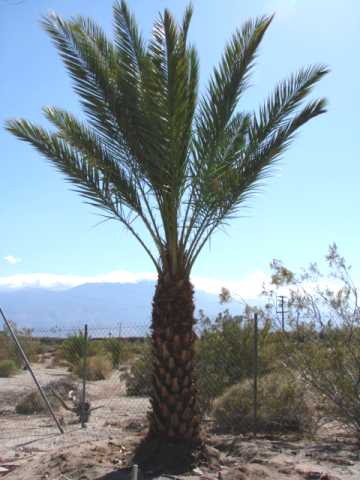
Medjool Date Palms & Tree Ripened Medjool Dates
We have date palms available in all sizes, including male date palms for pollination and for landscaping, and female medjool date palm offshoots for date production.We also have zahidi date palm offshoots available.
Our fresh picked medjool date program has been a huge success!
At certain times of year, we can ship orders for organically grown freshly picked medjool dates, as well as other date varieties and also organically grown mesquite seed pods. We also occasionally have a variety of other rare and exotic fruits that were grown organically and allowed to fully ripen on the tree.
Our fresh medjool dates are available in September-October each year.
Frequently Asked Questions
- SHIPPING: For small to medium size trees, we recommend that customers personally pick up their own trees and take them home in their vehicle. Local delivery of your selections to your driveway can usually be arranged (only in Southern California, minimum purchase $250) with a delivery cost from $50 to $150 depending on the round-trip mileage (50 mile maximum round-trip travel distance). Transport for large trees/palms can also be arranged. We do not offer "mail order" shipping for plants & trees.
- MEDJOOL DATE PALMS: Our Medjool date palm offshoots (and our other palm varieties) are grown near Palm Springs, in California. Medjool date palm offshoots in 15 gallon pots are available for pick-up in Rancho Cucamonga, California, by appoinment only. Delivery of Medjool date palms to homeowners in Southern California can be arranged. We do recommend homeowners hire an experienced landscaper (we are not offering landscaping services, sorry!) for planting & irrigation services.
- SUB TROPICAL FRUIT TREES: Available for pick-up in Rancho Cucamonga, California, by appoinment only, at one of our two locations. To make an appointment & get directions, please call 909 941 1060 a few days prior to your desired appointment time.
- PAYMENT: We accept Cash, Check, American Express, Visa, Mastercard & Discover. You can pay in advance or at the time of pick up.
- MAILING ADDRESS: Tropical Oasis Farms, PO Box 1011, Rancho Cucamonga, California 91729
- Grafted trees, trees grown from cuttings, off-shoots, and air layered trees are described as such. All other trees are seedlings.
- SEEDS: We do offer organically grown SEEDS year round: medjool date seeds and organically grown in California MESQUITE SEED PODS
- FRESH MEDJOOL DATES: organically grown in California, fresh picked medjool dates are available in October each year.
- GUARANTEE: We guarantee our plants and trees to be in good condition at the time of sale.
- SUITABILITY: For questions regarding the suitability of plants or trees for your climate (and how to care for them), the CRFG website has lots of great information.
- For all other questions, you may contact us at: Tropical Oasis Farms, PO Box 1011, Rancho Cucamonga, California 91729
© Copyright 1999-2025 - tropicaloasisfarms.com® - All Rights Reserved.
